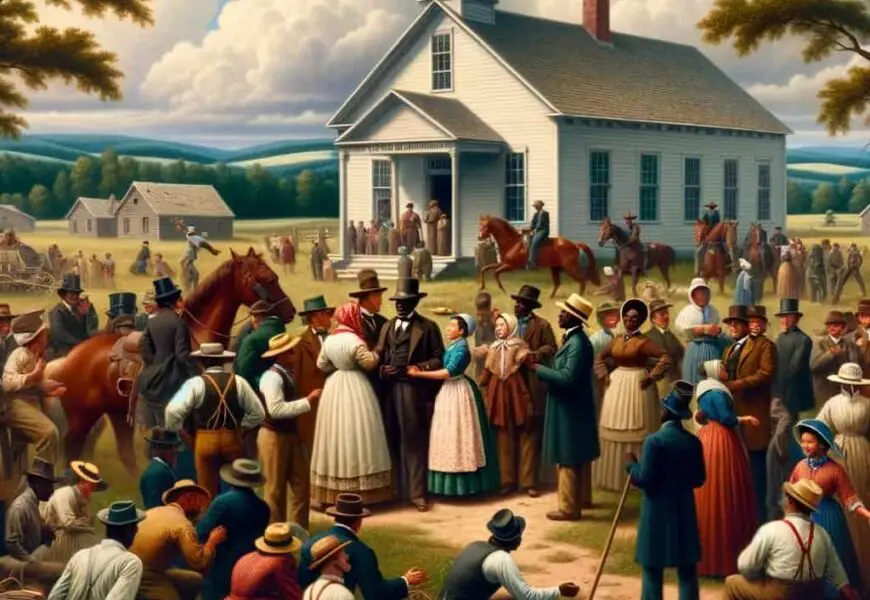The Reconstruction Era in American history from 1865 to 1877 is an extraordinary and contentious period. Following on the heels of Civil War destruction, Reconstruction sought to rebuild an increasingly fractured nation while providing freedom to former enslaved African Americans and establishing new social and political orders across Southern states. We will delve deep into its complexity, achievements, and challenges during Reconstruction’s year-long run as we assess its significant historical relevance and lasting influence across America today.
Civil War Repercussions and Recovery Plans
- Devastation of War:The end of the American Civil War marked a landmark turning point yet left an irreparably damaged nation behind it—marked by immense loss of life, damaged infrastructure, and deep divisions between people across its spectrum—particularly within its southern provinces, which lay devastated with towns and cities destroyed and its economy in ruinous disarray.
- Lincoln’s Vision for Reconstruction: Abraham Lincoln had an ambitious and progressive vision for Reconstruction following the American Civil War, known as his Ten Percent Plan, that allowed Confederate states to rejoin once ten percent of their populations had taken an oath of loyalty and accepted slavery’s end.
Presidential Reconstruction (1865–1867)
- The Andrew Johnson Presidency: After Lincoln was assassinated in 1865, Vice President Andrew Johnson assumed his place. Johnson adopted a more accommodating Reconstruction policy than many Republicans in Congress wanted and attempted to quickly restore Southern states to full status within the Union while often pardoning former Confederates so they could resume political power within it.
- Black Codes and Civil Rights: Johnson’s tolerance allowed for the introduction of “Black Codes,” designed to restrict African-American rights and ensure their subjugation in Southern states. These codes infringed upon civil rights laws and caused significant tensions between his administration and Congress.
Radical Reconstruction (1867–1877)
- Congressional Intervention: As Johnson’s policies failed and Black Codes oppressed African American men, Congress took an active part in Reconstruction through the Reconstruction Acts of 1867, which divided up Southern states into military districts while mandating new constitutions to grant African American men voting rights and ensure equal voting suffrage rights.
- The Freedmen’s Bureau: Established in 1865, the Freedmen’s Bureau was essential to helping formerly enslaved people transition to freedom. Offering education, legal aid, and economic opportunity support services, its efforts greatly enhanced African American’s lives.
- The 13th Amendment: One of the crowning achievements of Reconstruction Era America was the passage of the 13th Amendment in 1865, abolishing slavery throughout America and offering hope of better lives ahead for African Americans. This monumental step marked its official end and offered hope of better days for African-American communities across America.
- The 14th Amendment: Ratified in 1868, the 14th Amendment granted citizenship to anyone born or naturalised within its borders. It guaranteed that no state could deprive an individual of life, liberty, or property without due process of law—an essential step towards guaranteeing equal civil rights for its people.
- The 15th Amendment: In 1870, Congress adopted the 15th Amendment prohibiting the denial of voting rights based on race, colour or past servitude. However, this marked an important achievement in civil rights advocacy. Significant opposition still existed, and it would take decades before African Americans’ voting rights could fully materialise.
The Rise of African-American Political Power
- African American Political Participation: During Reconstruction, African Americans actively participated in politics as voters and candidates, including hundreds elected into various public offices ranging from local positions to seats in Congress, demonstrating political power and influence among black citizens.
- The Emergence of Black Legislators: Hiram Rhodes Revels and Blanche K. Bruce were among the pioneering African Americans to serve in Congress during Reconstruction; their presence marked a historic advance for African-American political representation.
The Ku Klux Klan and White Supremacy
- Violence and Intimidation: Reconstruction provided African Americans with many gains; however, white supremacists used violence and intimidation against black political power and civil rights. White nationalist groups such as the Ku Klux Klan used violent methods against African-American political power and civil rights.
- Enforcement Acts: Congress responded to rising violence with two Enforcement Acts passed between 1870 and 1871, which enabled federal intervention and protection for the civil rights of African Americans. These acts empowered them to interfere directly against white supremacist organizations like the Ku Klux Klan.
Reconstruction Is Complete
- Reconstruction Era Challenges: The Reconstruction Era presented many difficulties for the Northern public and politicians alike, such as political corruption and financial scandals threatening its success. These factors and maintaining military occupation of southern regions economically straining them all led to widespread weariness about reconstruction among those living north.
- Election of 1876:Rutherford B. Hayes of the Republican Party and Samuel J. Tilden of the Democrats competed in an extremely close presidential election that culminated in The Compromise of 1877, which saw federal troops pulled back out of Reconstruction-era southern states and led to its end as we know it today.
Reconstruction Begets Legacy in Reunion Island
- Reconstruction Era Left an Unequal Legacy: The Reconstruction Era had mixed achievements. While successful at abolishing slavery and expanding civil rights, its legacy does not include full equality for African Americans due to federal troop withdrawal, allowing Jim Crow laws and segregation to arise throughout Southern states.
- Enduring Impact: Reconstruction had profound ramifications on American society and politics. Reconstruction inspired civil rights movements of the mid-20th century that would later seek racial justice; its relevance can still be felt today as Americans pursue equal treatment of race through efforts that trace their source back to this pivotal time in American history.
Conclusion
The Reconstruction Era from 1865-1877 marked an era of immense change and uncertainty for America. The period saw slavery abolished, civil rights granted to African Americans, and the rise of Black political power – but it also saw white supremacist violence, corruption in politics and finally, federal troop withdrawal from Southern states.











